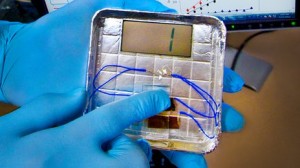Here comes the grey goo! Scientists at U.C. Berkeley have created a tiny generator using a combination of pressure and a film of specially engineered viruses that covert mechanical energy into electricity. You can read the BBC story here.
The viruses – which apparently only attack bacteria and are harmless to humans (for now) – can only produce enough energy to make the number “1” light up on an LCD. But think about what we’ve got here: potentially self-replicating, self-assembling viruses that get more energetic under pressure. This is going to be grey goo, right? This is what could power nanotechnology gone wild – tiny little virus-powered robots proliferating all over the place, pushing life as we know it out of the way.
Okay, okay, so I’m going a bit overboard on the scifi side, but remember that the grey goo scenario wasn’t thought up by science fiction writers, but by mathematical genius John von Neumann and nanotech researcher Eric Drexler. As long as we’re just talking about robotics and electronics, we really don’t have much to worry about, but once you start throwing biological material in – material that is designed to evolve and adapt on its own – then things get much more interesting.
Anyway, this is definitely the sort of development that inspires the science fiction mind. Not only is there the catastrophic scenario to play around with, but also the possibility that this technology could be used to set up a powerplant on another world – Mars, for instance – before humans ever get there. All it needs is some pressure. In the far distance future, energy from viruses might contribute to a terraformation program – part of the process of turning a barren area of a world into an area that can support life.
So, we can dream up constructive outcomes as well. The problem is that very little consideration has been given to the management of scientific discoveries in terms of public policy. Consider the debate about cloning, for instance, which was superficial and partly religious, never really getting at the real risks and potential rewards of the technology. And what about stem cell research? The point is, once a scientific development is made, we seem to be decreasingly able to talk coherently, as a society, about what to do with it – what to tolerate, and what not to. Are we even going to talk about nanotechnology, or will we just let ourselves be plunged into the new age, as we did with nuclear power? Because the risks and rewards of nuclear power were never fully aired, never made clear to the public, the Three-Mile Island scare tainted the technology and it has been under-utilized ever since. Any technology can suffer the same fate.
For now, though, we’ve just got a film of electricity-producing viruses, so maybe I shouldn’t jump ahead of the story too much. Congratulations to the researchers at my alma mater for their good work!
